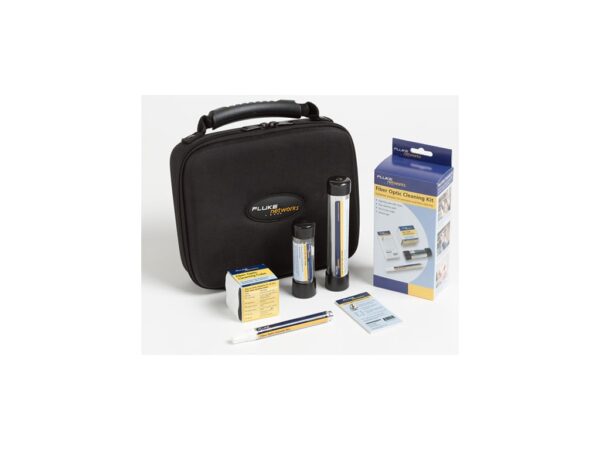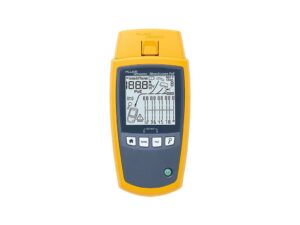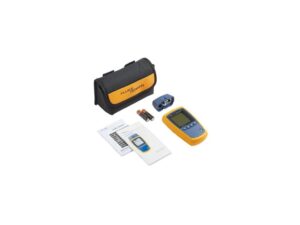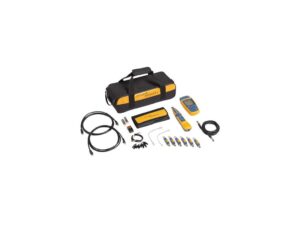Fluke Networks NFC-KIT-CASE Fiber Optic Cleaning Kit with Case
$229.18
Contains everything needed to eliminate the #1 cause of fiber link failure: contamination
All components enable optimal wet and dry cleaning sequence
Specially-designed fiber solvent is precisely dispensed from pen
Cleaning cards are perfectly convenient for troubleshooting
Various swabs are designed to fit many styles of connector ports
Rugged carrying case stores and transports all cleaning tools
Cleaning Instructions
What to avoid when cleaning end-faces
Specialized Solvent
Fluke Networks® NFC-KIT-CASE Fiber Optic Cleaning Kit
ALL FIBER CONNECTION TYPE
CLEANING CARDS
SOLVENT PEN
RUGGED CARRYING CASE
Fiber Optic Cleaning Kits
The Fluke Networks® NFC-KIT-CASE Fiber Optic Cleaning Kit includes cleaning cube with wipes, ten cards with sealed cleaning zones, solvent pen, 2.5mm port cleaning swabs and 1.25mm port cleaning swabs in a rugged carrying case. Because the #1 cause of fiber optic cabling failures is due to contaminated end-faces, it is imperative that all optical fiber connections are clean and free of contaminants. Fluke Networks® Fiber Inspection & Cleaning Tools are the solution. Whatever your particular needs are, Fluke Networks® provides you with the solution to ensure your fiber connections don’t bring your network down.
Use Fluke Networks®’ Fiber Optic Cleaning Kits to ensure all fiber end-faces are clean before every mating.
Dirt, dust and other contaminants are the enemy of high-speed data transmission over optical fiber. Today’s network applications require more bandwidth, making loss budgets tighter than ever. It is critical that all optical connections are clean and free of contaminants to ensure application success.
Fluke Networks®’ Fiber Optic Cleaning Kits have the best tools to effectively remove the toughest contaminants with ease. Choose between the convenient Cleaning Cards or miniature Cleaning Cube when cleaning patch cords and select the appropriate-sized swabs when cleaning inside ports. All cleaning materials are lint-free and enable an optimal wet and dry cleaning process.
The rugged carrying case is ideal for carrying and storing the cleaning components. Each kit contains detailed cleaning instructions as well as permanently affixed reordering details. An elasticized pouch permits storage of additional items such as patch cords, adapter, etc.
Cleaning Instructions
Inspect every end-face first. If it is clean, then it can be inserted as is. Most likely, it has accumulated some form of contamination and needs to be cleaned right before insertion:
Cleaning patch cords with a Cleaning Card:
Remove the plastic cover from one cleaning zone.
Apply a minimal spot of solvent to the starting corner of the cleaning zone.
Holding the connector perpendicularly, swipe the end-face from the wet spot into a dry zone.
Inspect again to ensure a complete cleaning. If necessary, expose a new cleaning zone and repeat steps again.
Cleaning patch cords with a Cleaning Cube:
Pull a clean wipe from the Cleaning Cube.
Apply a minimal spot of solvent to the starting edge of the wipe.
Holding the connector perpendicularly, swipe the end-face from the wet spot into a dry zone.
Inspect again to ensure a complete cleaning. If necessary, repeat the steps again on a new portion of the exposed wipe on the Cube.
Cleaning inside ports with Swabs:
Pull a clean wipe from the Cleaning Cube.
Apply a minimal spot of solvent to the wipe.
Touch the swab to the wet spot on the wipe for 3 seconds to absorb a minimal amount of solvent. A damp swab works better than a wet one.
Insert the swab into the port and turn several times while applying gentle pressure.
Follow the damp swab with a dry one, using the same procedure to remove any remaining solvent from the end-face and alignment sleeve.
What to avoid when cleaning end-faces
There are as many different cleaning techniques as there are fiber optic network technicians. While some techniques work some of the time, reliable and lasting performance of your fiber links require inspection and proper cleaning processes with every mating. Here are some well-known bad habits:
Dry Cleaning:
Cleaning end-faces without use of any solvent is not only likely to be ineffective, but it can actually cause more problems. Using a dry cleaning method will only be effective on one type of contaminant: skin oil. For all other types of contaminants, dry cleaning is dangerous. For dust and debris, a lack of solvent can allow these particles to scratch or chip the end-face as they are wiped away. Use of specialty solvent effectively lubricates the particles and lifts them from the surface of the ferrule so that they do not cause damage as they are trapped by a lint-free cleaner. Further, dry cleaning can generate a static charge that will draw more dust to the end-face in the time it takes you to plug your connector into a port. Fluke Networks®’ solvent is oxygenated and therefore will not only prevent generation of an additional charge, but also it will neutralize any preexisting static charge.
Wet Cleaning:
Cleaning with only a pre-soaked wet wipe or excessive solvent will leave liquid behind on the end-face which also causes problems. As that excess solvent dries, it can leave behind of film of dissolved contaminants that were never properly removed. In addition, residual isopropyl alcohol (IPA) can leave behind a “halo” as it dries that not only causes attenuation, but also can be very hard to remove. No solvent should remain at the conclusion of a cleaning.
Canned Air and Dusters:
Canned air and dusters are ineffective and should not be used to clean end-faces. The only thing dusters do is blow large particles around. On a patch cord, this may be effective, but inside a port this can result in those same particles settling elsewhere. Dusters are ineffective on smaller, statically-charged particles and totally useless on oil-based contaminants such as buffer gel or body oil. Last, dusters often expel a propellant that becomes a whole new contaminant that now requires an effective cleaning process to remove.
Thinking New Equals Clean:
Do not be lulled into thinking that end-faces on factory-terminated patch cords or pigtails will be clean when they are brand new and covered with a dust cap. Though dust caps are great at preventing damage to the end-face, the caps themselves can be a source of contamination. The plastic used to create dust caps will outgas a residue as its plasticizers deteriorate over time and the surface of the cap may contain mold-release substances used in their high-speed production process. Don’t be surprised to find a contaminated end-face upon removal of a protective cap. For repeatable and reliable end-face cleaning, always use Fluke Networks®’ tools to follow the recommended wet and dry process.
Specialized Solvent
For years isopropyl alcohol (IPA) was used to clean fiber end-faces, but now there are customized solvents that are far superior, such as Fluke Networks®’ Fiber Optic Solvent Pen. Most importantly, this specialized solvent is more effective than IPA at dissolving all contaminants, especially non-ionic compounds such as buffer gel and pulling lube. You will get a better clean every time and with every contaminant.
Next, our solvent has a lower surface tension than IPA that allows it to envelop particles and debris, effectively lifting them from the surface of the end-face as they are carried away by a wipe or swab. Many smaller particles carry a charge that bonds them to the ferrule or an end-face. Unlike IPA, this solvent is oxygenated to neutralize this charge so that the charged particle can be removed and more particles are not attracted onto the end-face. When cleaning end-faces inside ports or equipment, the evaporation rate of solvents become significant as it is harder to guarantee removal of all solvent. Fluke Networks®’ customized solvent has an evaporation rate tailored to stay long enough to work yet still disappear before mating. It evaporates much faster than IPA. IPA is highly hygroscopic and therefore draws water vapor that can then dry on the end-face and leave a residue, which sometimes appears as a “halo”. Using Fluke Networks®’ solvent will avoid this problem.







Reviews
There are no reviews yet.